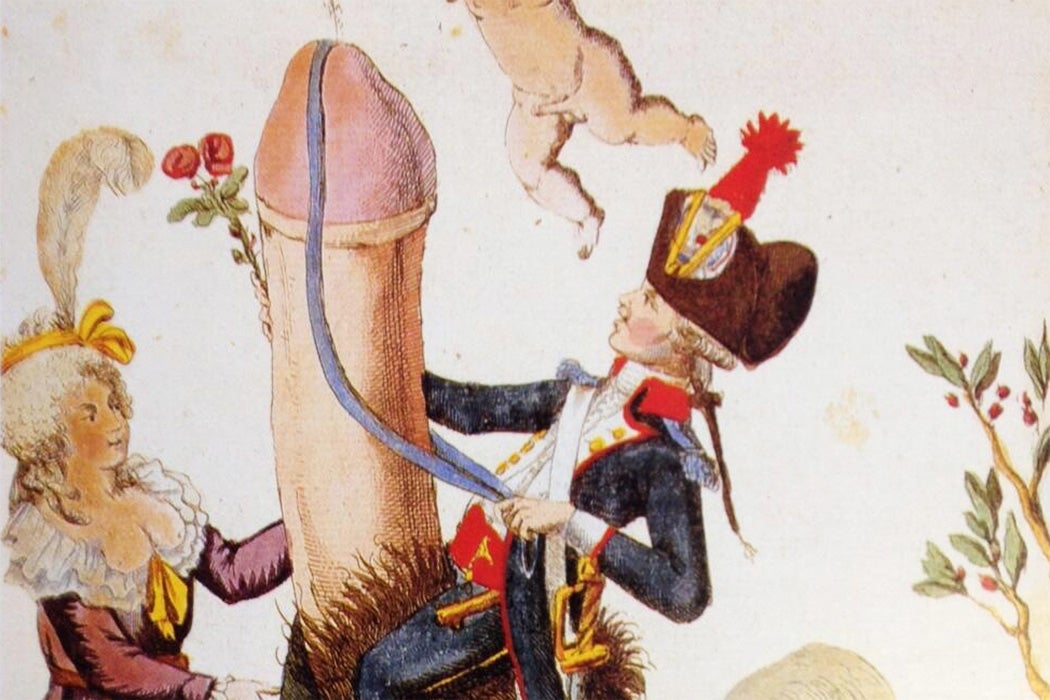During the French Revolution, ludicrously pornographic pamphlets like the one featured above, mocked Marie Antoinette, who received a disproportionate amount of gendered propaganda and vilification, especially compared to what her husband endured. A fair amount of it consisted of sexualized caricatures. She was portrayed, says scholar Pierre Saint-Amand, as an amalgam of “assembled monsters, hybrid creatures, and a whole procession of deformed beings.” Indeed, Marie Antoinette became the victim of “an extended conservative discourse in the Age of Reason,” which took umbrage against the supposed “effeminization of culture by noble-women, their intellectual promiscuity in the salons, their involvement in political debates.” The dehumanization of Marie Antoinette through devices of mockery turned her image as a liberated woman against her. It reduced her to an object of ridicule. Humor, usually considered positive if not benign, can also increase tolerance of prejudice towards those being ridiculed. It makes the expression of this prejudice enjoyable.
The most basic form of humor relies on stereotypes, which serve as shorthand for making sense of the world. Humor that relies on ethnic and racial stereotypes encourages cultural racism. It took years for the dark history of Japanese internment in the United States to become a subject of public discussion, but comics depicting the Japanese as laughably evil and incompetent were popular during World War Two. The imperialist history of Western aggression in the Middle East has been all but forgotten, but the stereotype of Muslims inability to “take jokes” persists. As media scholar Simon Weaver points out, comedy acts as a shortcut to the supposed truth; jokes strengthen the stereotype by making their central message momentarily “true.” So, when the President of the United States says we need to ban people from Islamic countries from entering the country, it’s easier to fall in line with the exclusionary rhetoric that forms the basis of this kind of prejudice. The jokes we hear stay with us, often inseparable from the truth; they are a substitute for the complex history of the communities they mock and pave the way for implicit (if not explicit) bias.
Humor theorists attribute the so-called superiority theory of humor to explain jokes that punch down. Its purpose is to make joke tellers—and receptive audiences—feel better by insulting others. Such a practice is rooted in Plato and Aristotle’s argument—the first notable theory of humor—that a key function of “humor and laughter is tied to perceiving others as inferior,” paraphrases sociologist Raúl Pérez in his article “Racism without Hatred? Racist Humor and the Myth of ‘Color-blindness.’” Also known as disparagement humor, it targets disempowered social groups, reaffirming systemic inequalities.
Weekly Newsletter
“Executioner’s Humor” was a term coined by folklorist Alan Dundes and anthropologist Thomas Hauschild in 1983 to explain the popularity of anti-Semitic jokes in West Germany during the 1980s. Gallows humor, the resort of the helpless, therein met its match in the ammunition of those in power.
Why did so many Jews go to Auschwitz?
The fare was free.Was ist der Traum eines Juden?
What is a Jew’s dream?
Ein Fensterplatz im Hochofen
A window-seat in a high oven.
These kinds of jokes assuaged Germans’ guilt over the Holocaust with the sly implication that Jews as a group enjoy being gassed. Hygiene-themed jokes played off the “dirty Jew” stereotype and affirmed myths about Aryan purity; they were also a metaphorical nod to the German attempts to turn the corpses of the Jewish people they murdered into soap. Waves of Turkish immigration in the sixties begat a cycle of jokes that unfavorably compared Jews and Turks people; in these jokes, the association with dirt was transferred to Turkish people, the new outsiders, while Jewish people were symbolically reduced to “ashes.” They had already been annihilated.
Executioner’s humor was a way of acknowledging the Jewish genocide as part of German history while simultaneously denying its horrors. The ease of denial, dissociation, and detachment permitted by humor often serves the cause of hatred when it comes to disparagement of those whom we perceive to be unlike us. It allows the joke-teller to disavow racist/sexist/ableist intent, further normalizing negative stereotypes of the marginalized and trivializing the atrocities they experience.
The normalization of anti-Blackness through humorous expression can be found in European literature as far back as the sixteenth century. Theatrical traditions including the character of the black-masked devil who was simultaneously foolish and evil, constructed the same racialized associations of incompetence, idiocy, and irrationality that have been recognized in the figures of minstrelsy as well as other forms of blackface comedy. Renaissance scholar Robert Hornback notes that these representations went a long-way in justifying slavery. “Antebellum whites were determined to ‘prove’ a connection between blackness and irrationality,” he writes, “especially when ‘the Negro’ was left to his own devices.” Jim Crow policies—literally named for the first-known minstrel character—and the legal denial of freedoms such as the right to vote were premised on the false truism of the “natural” mental debility of Black people. The fact that these representations flourished prior to the formal organization of the transatlantic Black slave trade reflects how the dehumanization of certain social groups predates their historically acknowledged subjugation and mistreatment.
Comedic anti-Blackness also helped build a “white solidarity” that cut across other differences. Pérez finds that ridiculing Black people created “a common symbolic language… As a social activity, the pleasurable ridicule of blacks allowed European immigrants from various class, national, and ethnic backgrounds, with distinct interests, cultures, traditions, and languages, to view themselves not only as ‘white’ but also as racially superior.” Racist joking, Pérez notes, is embedded in the culture of American police departments, defended as “a necessary evil, serving to bond coworkers in the grueling fight against crime.” That is, humor is said to help build community.
Jokes such as “How does a black woman fight crime? She has an abortion,” or the video trailer of police dogs in KKK imagery that came out of the Fort Lauderdale police department in 2015 demonstrate that it is impossible to separate anti-Black police brutality from the racist jokes being shared within the halls of law enforcement. In Pérez’s article in the journal Sociological Perspectives Public defender Howard Finkelstein affirms, “if people think the beating of black young men is funny, then they are willing to beat young black men, period, end of story.”
During the 2016 US presidential elections, internet memes were an influential form of alt-right messaging. As media studies scholar Viveca Greene highlights, “ (Donald) Trump’s presidential bid and successful campaign capitalized on memes as forms of communication and activated their hitherto latent political power. Trump effectively put a torch to the clandestine fuel of online white supremacy, and media outlets provided the necessary oxygen.”

These memes mainstreamed the Islamophobic, sexist, racist, and homophobic ideas of White supremacist messaging, making them more attractive to a younger audience. Greene observes that “the alt-right movement relies on irony, humor, and memes for recruitment and radicalization on the internet.” The interconnectedness of the global internet enabled these memes to spread far and wide in a short time.
Even though the rise of the alt-right is closely associated with the ascent of Trump, the cultural moment when the alt-right rose from the fringes can be traced back to the Gamergate harassment campaign of 2014 and 15, wherein the vitriol against women gamers took a dangerous turn, with the barrage of misogynistic humor being accompanied by violent doxxing. Andrew Anglin, founder of neo-Nazi website Daily Stormer, explicitly pronounced that Gamergate “provided a direct entry-point to what is now called the Alt-Right, as it was made-up of young White men who realized they were being disenfranchised by feminism and political correctness when aggressive SJWs [social justice warriors] began invading their space and making demands of them, and ended up digging into the ‘dark corners of the internet’ to try and figure out what was happening.” Indeed, the contemporary use of disparagement humor is often framed as a challenge against the scourge of political correctness believed to have beset America.
Socialists in the 1940s were among the very first to use the term “political correctness” to mock the dogmatic attitudes within the American Communist Party. This term was appropriated by the conservative backlash against the gains—real and perceived—of the Civil Rights Movement. In an era where overt racism was stigmatized, racist humor was framed as an attack against the excesses of political correctness. The mass popularity of joke books in the 1980s, such as Truly Tasteless Jokes, was due to their promise to “offend everybody” with offerings such as the following:
What do you call a black boy with a bicycle? Thief!
What’s the new Webster’s definition of the word “confusion?” Father’s day in Harlem.
Racist jokes such as these destroy the myth of a color-blind America, because readers “must be ‘color-conscious’ rather than ‘color-blind’ to ‘get the joke.’” While being politically incorrect started off as being anti-establishment, its contemporary usage is largely to reframe status quo-ist justifications for discriminatory behavior as revolutionary truth-telling. The tools of humor have helped in this process of subverting meaning, by making it edgy and cool to be “politically incorrect.” Pérez’s work illustrates that “the success of the ‘equal opportunity offender,’ as a challenge to ‘political correctness,’ was in deflecting charges of racism, while simultaneously allowing individuals, whites in particular, to circulate racist jokes in public under the guise of ‘just jokes’ and ‘free expression’ during a period where serious forms of racist discourse were increasingly unacceptable.”
The Internet era has also accelerated a provincial understanding of free expression and free speech. The origins of the First Amendment lay in protecting the right of citizens to dissent against authoritarian decisions by the State; that is, ordinary people are protected from punitive action by the government. On social media platforms, this idea of political-incorrectness-as-free-speech functions as a license to spread “white supremacist thought, Islamophobia, and misogyny through irony and knowledge of internet culture,” according to Greene. Like political correctness, this re-appropriated meaning of free speech is not restricted among right-wing circles but is globally considered a tenet of liberalism.
Indeed, the killings of journalists at the French periodical Charlie Hebdo owing to its publication of cartoons mocking the Prophet Mohammad was framed as an attack on free speech. Communications scholar Matt Jones argues that reducing an editorial take, in which “the politics of anti-oppression and integration have come second to the pleasures of taunting communities who find themselves disfavored in French society,” into a simple free speech issue ignores the historically imbalanced power dynamics between the French state and its Muslim constituents. An uncritical understanding of free speech and secularism allows a “black humor” publication like Charlie Hebdo to bolster an Islamophobic agenda all while fitting under the liberally championed aegis of freedom of expression.
Charlie Hebdo’s aesthetic commitment to anarchic humor, via the use of violence, explicit language, and crossing the conventional threshold of morality, does not prevent it from slipping into exclusionary and oppressive messaging. As Jones explains, “there is no way to cleanly separate a pure anarchic spirit from the social conditions in which it operates. On the contrary, the question of whether a cultural product intervenes in an anarchist way has more to do with the kind of social interactions it provokes than with its formal commitment to anarchist principles such as anti-statism, anti-authoritarianism, free thinking, or mutual cooperation.”
When wrapped in a joke, notions that justified (and sometimes still do) the tragic histories of slavery, anti-Semitism, Islamophobia, violence against women, and so forth appear alluringly subversive. But, if they fail to question established stereotypes and instead, perpetuate long-standing exclusionary beliefs, they are anything but subversive. Hatred disguised as a green frog with a doleful gaze is still hatred.
Support JSTOR Daily! Join our new membership program on Patreon today.







